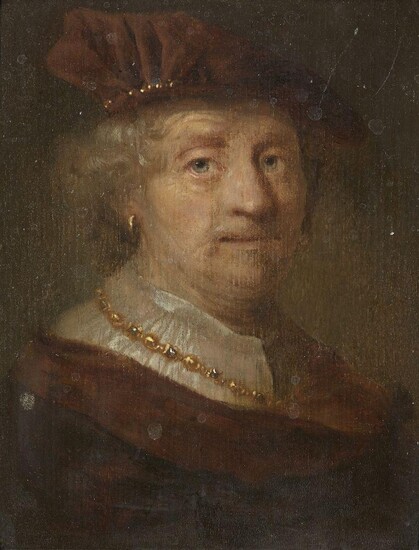Follower of Govaert Flinck, Dutch 1615-1660- A man, head and shoulders, in a brown cloak, velvet cap and gold chain; oil on panel, bears old typed label '1 Head of Bergomaster, by Ferdinand Bol (signed)' on the reverse, 15.8 x 12.4 cm. Provenance:...
Follower of Govaert Flinck, Dutch 1615-1660- A man, head and shoulders, in a brown cloak, velvet cap and gold chain; oil on panel, bears old typed label '1 Head of Bergomaster, by Ferdinand Bol (signed)' on the reverse, 15.8 x 12.4 cm. Provenance: Anon. sale, Christie's, London, 26 September 1980, lot 50 (as 'BOL').; Private Collection, UK. Note: Renowned as one of Rembrandt’s most talented protégés, Flinck was his pupil from 1633 until 1636, when he set up as an independent master. Like many of Rembrandt's best pupils from his early Amsterdam phase such as Ferdinand Bol (1616-1680) and Jacob Backer (1608-1651), Flinck evolved a style that is distinctive and personal, but until at least the end of the 1640s remained palpably Rembrandtesque. The present work is a tronie, or fancy-dress study, based on a real likeness. Rembrandt developed the tronie and painted many of them from his Leiden period onwards, though they fell out of fashion after the 1640s. Flinck, along with many of Rembrandt's pupils from the first decade of his Amsterdam period, continued to produce tronies in large numbers, presumably to meet the great demand for them, and indeed, students and studio assistants as well as friends and family no doubt provided his models. Simon Schama certainly had the Rembrandtesque tronie at the forefront of his mind when he remarked to camera ‘Dutch art has a very large hat department.’ (‘The Face of Britain’, broadcast BBC2, 28th October 2015). This tronie, of an elderly gentleman in exotic dress, is a confident example of the type. The sitter, with his engaging eyes and pleasing countenance, looks towards the viewer. His features are softly modeled by a light that illuminates the scene from the upper left, casting shadows that define his face. In overall type, the painting may be compared with both Flinck’s ‘Head of an Old Man’ in the National Gallery of Ireland, Dublin, c.1642 (NGI.254) and his ‘Bearded Man with a Velvet Cap’, 1645, at the Metropolitan Museum of Art [25.110.27]. See, also, Rembrandt’s ‘Self-portrait’, 1633, in the Louvre, Paris [INV 1745 ; MR 937] for an example of the tronie type developed by the older master.
Please refer to department for condition report
View it on
Sale price
Estimate
Reserve
Time, Location
Auction House
Follower of Govaert Flinck, Dutch 1615-1660- A man, head and shoulders, in a brown cloak, velvet cap and gold chain; oil on panel, bears old typed label '1 Head of Bergomaster, by Ferdinand Bol (signed)' on the reverse, 15.8 x 12.4 cm. Provenance: Anon. sale, Christie's, London, 26 September 1980, lot 50 (as 'BOL').; Private Collection, UK. Note: Renowned as one of Rembrandt’s most talented protégés, Flinck was his pupil from 1633 until 1636, when he set up as an independent master. Like many of Rembrandt's best pupils from his early Amsterdam phase such as Ferdinand Bol (1616-1680) and Jacob Backer (1608-1651), Flinck evolved a style that is distinctive and personal, but until at least the end of the 1640s remained palpably Rembrandtesque. The present work is a tronie, or fancy-dress study, based on a real likeness. Rembrandt developed the tronie and painted many of them from his Leiden period onwards, though they fell out of fashion after the 1640s. Flinck, along with many of Rembrandt's pupils from the first decade of his Amsterdam period, continued to produce tronies in large numbers, presumably to meet the great demand for them, and indeed, students and studio assistants as well as friends and family no doubt provided his models. Simon Schama certainly had the Rembrandtesque tronie at the forefront of his mind when he remarked to camera ‘Dutch art has a very large hat department.’ (‘The Face of Britain’, broadcast BBC2, 28th October 2015). This tronie, of an elderly gentleman in exotic dress, is a confident example of the type. The sitter, with his engaging eyes and pleasing countenance, looks towards the viewer. His features are softly modeled by a light that illuminates the scene from the upper left, casting shadows that define his face. In overall type, the painting may be compared with both Flinck’s ‘Head of an Old Man’ in the National Gallery of Ireland, Dublin, c.1642 (NGI.254) and his ‘Bearded Man with a Velvet Cap’, 1645, at the Metropolitan Museum of Art [25.110.27]. See, also, Rembrandt’s ‘Self-portrait’, 1633, in the Louvre, Paris [INV 1745 ; MR 937] for an example of the tronie type developed by the older master.
Please refer to department for condition report



